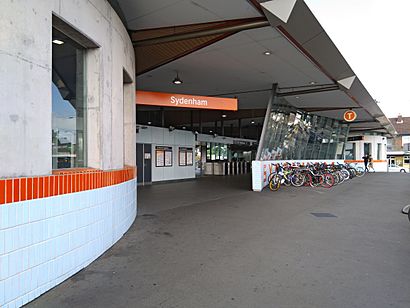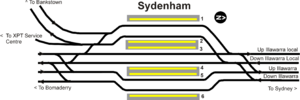Sydenham railway station, Sydney facts for kids
Quick facts for kids
Sydenham
|
||||||||||||||||||||||||||||||||||||
|---|---|---|---|---|---|---|---|---|---|---|---|---|---|---|---|---|---|---|---|---|---|---|---|---|---|---|---|---|---|---|---|---|---|---|---|---|

Railway Road entrance in October 2017.
|
||||||||||||||||||||||||||||||||||||
| Location | Gleeson Avenue, Sydenham | |||||||||||||||||||||||||||||||||||
| Coordinates | 33°54′52″S 151°10′00″E / 33.914525°S 151.1665333°E | |||||||||||||||||||||||||||||||||||
| Owned by | Transport Asset Holding Entity | |||||||||||||||||||||||||||||||||||
| Operated by | Sydney Trains | |||||||||||||||||||||||||||||||||||
| Line(s) |
|
|||||||||||||||||||||||||||||||||||
| Distance | 5.31 kilometres from Central | |||||||||||||||||||||||||||||||||||
| Platforms | 6 (2 island, 2 side) (2 currently closed) |
|||||||||||||||||||||||||||||||||||
| Tracks | 6 | |||||||||||||||||||||||||||||||||||
| Connections | Bus | |||||||||||||||||||||||||||||||||||
| Construction | ||||||||||||||||||||||||||||||||||||
| Structure type | Ground | |||||||||||||||||||||||||||||||||||
| Disabled access | Yes | |||||||||||||||||||||||||||||||||||
| Other information | ||||||||||||||||||||||||||||||||||||
| Status | Staffed | |||||||||||||||||||||||||||||||||||
| Station code | SDN | |||||||||||||||||||||||||||||||||||
| Website | Transport for NSW | |||||||||||||||||||||||||||||||||||
| History | ||||||||||||||||||||||||||||||||||||
| Opened | 15 October 1884 | |||||||||||||||||||||||||||||||||||
| Electrified | Yes | |||||||||||||||||||||||||||||||||||
| Previous names | Marrickville | |||||||||||||||||||||||||||||||||||
| Traffic | ||||||||||||||||||||||||||||||||||||
| Passengers (2013) | 5,620 (daily) (Sydney Trains, NSW TrainLink) | |||||||||||||||||||||||||||||||||||
| Rank | 46 | |||||||||||||||||||||||||||||||||||
| Services | ||||||||||||||||||||||||||||||||||||
|
||||||||||||||||||||||||||||||||||||
Sydenham railway station is a historic train station in Sydenham, a suburb of Sydney, Australia. It is on the Illawarra line. This station is served by Sydney Trains services, including the T3 Bankstown, T4 Illawarra, and T8 South lines.
The station was designed by the New South Wales Government Railways. It was built over many years, from 1884 to 1962. William Robinson built the first buildings in 1884. Sydenham station is so important that it was added to the New South Wales State Heritage Register on 2 April 1999. This means it is a special place that needs to be protected.
Contents
Sydenham Station's Story
Sydenham Railway Station first opened on 15 October 1884. Back then, it was called Marrickville railway station. It was built on a new set of tracks that went from Illawarra Junction to Hurstville.
The station had two main buildings. The western platform had a large brick building with separate toilets. The eastern platform also had a big brick building.
Becoming Sydenham Junction
The station changed its name to Sydenham on 19 January 1895. This happened when a new train line to Belmore opened. In 1896, Sydenham became a very important junction station. This was because the Bankstown line opened, and new platforms (3 and 4) were added.
The station was quite grand, probably meant for the main Marrickville area. But it was a bit far away from the town. It became busy mainly because it was a junction for different train lines.
Changes Over Time
In 1907, more tracks were added between Edgeware Road and Sydenham. This was to prepare for the Bankstown line extension in 1909. These new tracks meant the original station buildings were now on island platforms. Passengers had to use a long footbridge to reach them. Around 1914, a new timber ticket office was built over the tracks. Steel footbridges were also extended to all platforms.
In 1925, two more tracks were added for a planned Eastern Suburbs railway line. This led to a new brick building on Platform 6. In 1926, the train lines at Sydenham became electric. A refreshment room opened in 1927 for local factory workers. The extra tracks were never fully used for the Eastern Suburbs Railway. Instead, they mostly served the Bankstown line trains. In 1963, a brick office for parcels was built on Platform 1, but it closed in the late 1980s.
Modern Upgrades
The old timber ticket office on the footbridge burned down in the mid-1980s. A new brick ticket office and a shop were built on the old footbridge structure in the late 1980s. New roofs were also added over the stairs connecting to the platform buildings.
In February 2013, a big upgrade happened. A new concourse (a large open area) was built. It included four lifts and new stairs to reach the platforms. This replaced the older concourse and footbridge. The upgrade also added new ticket machines and a family-friendly toilet.
Today, Sydenham station has two side platforms (1 and 6) and two island platforms (2/3 and 4/5). Platforms 1 and 2 serve the Bankstown Line. Platforms 5 and 6 serve the Eastern Suburbs & Illawarra Line. Before the Airport line opened in 2000, most East Hills line trains used platforms 3 and 4. Now, most East Hills trains use the Airport line. However, some trains still use platforms 3 and 4 during busy times.
Just south of the station, the Metropolitan Goods Line crosses over a bridge built in 1925. This line goes to Port Botany.
Future Changes
Sydenham station is getting another big upgrade as part of the Sydney Metro City & Southwest project. A new concourse will be built at the northern end. Platforms 1 and 2 will be updated for the new Sydney Metro trains. This project is expected to be finished in 2024.
Train Services at Sydenham
| Platform | Line | Stopping pattern | Notes |
| 1 | closed for upgrades & conversion into Metro services; reopening 2024 | Opened 1962, closed 2019. | |
|---|---|---|---|
| 2 | closed for upgrades & conversion into Metro services; reopening 2024 | Opened 1907, closed 1928, reopened 1962, closed again 2019. | |
| 3 |
3
|
services to Central & the City Circle | T3 services started operating here on 6 January 2020 after major holiday trackwork. |
|
8
|
6 weekday morning peak services to Central & the City Circle | Original platform | |
| 4 |
3
|
services to Lidcombe & Liverpool via Bankstown | T3 services started operating here on 6 January 2020 after major holiday trackwork. |
|
8
|
4 weekday evening peak services to Campbelltown & Macarthur | Original platform | |
| 5 |
4
|
services to Bondi Junction | Opened 1907 |
| 6 |
4
|
services to Hurstville (weekday peak only) services to Cronulla, Waterfall & Helensburgh (weekday off-peak and weekends only) |
Opened 1928 |
Station Buildings and Features
Sydenham station has many interesting parts. These include the buildings on each platform, the overhead concourse, and the bridges.
Platform 1 Waiting Shed and Office
- Waiting Shed (1925): This shed has brick walls and a timber ceiling. It's a place where people can wait for their train.
- Parcels Office (1962): This dark brick building is at the end of Platform 1. It used to be for sending and receiving packages.
Platform 2/3 Building (1884)
This is an old brick building with a gabled roof. It has a separate toilet building connected by a walled area. The building has timber windows and double doors with arched fanlights above them.
Inside, the Station Master's office has a fancy pressed metal ceiling. It also has a special marble mantelpiece near the chimney. This marble mantelpiece is very rare to find in station buildings today.
Platform 4/5 Building (1884)
This is another old brick building with a hipped roof. It also has a separate toilet building connected by a roofed courtyard. The waiting area inside has a ripple iron ceiling and a chimney.
Platform 6 Building (1925)
This brick building is at the far end of Platform 6. It has a gabled roof. Many of its windows have been changed, but some original ones remain.
Modern Additions
- Overhead Concourse (2013): This is a modern concrete and glass structure. It's the main entry point from Gleeson Avenue.
- Platform Canopies (late 1980s): These are roofs that extend from the concourse over the stairs and connect to the platform buildings. They protect people from the weather.
Other Structures
- Gleeson Avenue Overbridge (1920s): This is a brick bridge with brick walls that goes over Gleeson Avenue.
- Brick Perimeter Walls (1925): These dark brick walls mark the edges of the station area.
Platforms
The station has two side platforms (Platforms 1 and 6) and two island platforms (Platforms 2/3 and 4/5). All platforms have asphalt surfaces and brick edges.
Green Spaces
There are small bushes planted at the eastern end of each platform, adding some greenery to the station.
Why Sydenham Station is Special
Sydenham Railway Station is very important to the history of New South Wales. It is a major junction station that has grown and changed a lot since 1884. It still has many original parts, like the 1884 platform buildings. These show how stations were built and adapted over time.
The station's awnings (the roofs over the platforms) also show how designs changed. From small original awnings to larger cantilevered ones added later. All the platform buildings are great examples of their style from different periods.
The station is considered rare because it has structures from the very first period of the Illawarra line, all the way up to the 1960s. For example, the Platform 2/3 building is rare because only a few stations on the Illawarra line still have an 1880s 3rd Class platform building. The Platform 4/5 building is also rare, with only a couple of other stations having this type from that time.
Sydenham railway station was added to the New South Wales State Heritage Register on 2 April 1999. This means it's a special place that helps us understand the history and design of railways in New South Wales.
Track Layout
Images for kids







